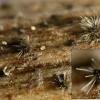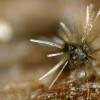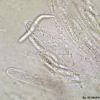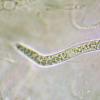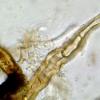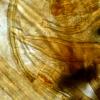
20-12-2025 23:08
Patrice TANCHAUDBonsoir, récolte sur sol sablonneux dans l'arri�

20-12-2025 15:47
Mirek GrycHi.These grew on pine wood that was heavily covere

18-12-2025 21:17
Pol DebaenstThe identification took me to Byssonectria deformi

15-12-2025 07:09
 Danny Newman
Danny Newman
indet. Rutstroemiaceae sp. on unk. fallen leavesMc

19-12-2025 10:10
Patrice TANCHAUDBonjour, récolte réalisée en milieu dunaire, a

18-12-2025 17:23
 Bruno Coué
Bruno Coué
Bonjour,je serais heureux d'avoir votre avis sur c

18-12-2025 18:07
Margot en Geert VullingsThese plumes were found on rotten wood.They strong

17-12-2025 18:35
 Michel Hairaud
Michel Hairaud
Bonjour à tous/Hi to everyone I am passing along
Lasiosphaeria
Björn Wergen,
24-06-2013 11:21
 Hi there,
Hi there,here is another problem, found in Austria on dead dicot stems. I hadn't ever seen any Lasiosphaeria species with so long, straight hairs, which are up to 310µm long.
Spores sometimes have 1 (perhaps 2) septation.
With the key available on the page I come to L. rufa (without setae septations) or L. caudata (spores are bigger).
Any idea?
regards,
björn
Andrew N. Miller,
24-06-2013 16:52

Re : Lasiosphaeria
This is Hilberina rufa.
Ascomata gregarious to densely crowded, globose to ovoid, 380-480 µm diam. x 480-550 µm high, setae pale reddish-brown, thick-walled with narrow lumen, blunt to acute ended; ascospores cylindrical, basal end curved in obtuse angle, attenuate and acerose with a slightly swollen enlarged tip, hyaline to yellowish, 3-septate, 48-58 x 3.5-3.8 µm
Andy
Ascomata gregarious to densely crowded, globose to ovoid, 380-480 µm diam. x 480-550 µm high, setae pale reddish-brown, thick-walled with narrow lumen, blunt to acute ended; ascospores cylindrical, basal end curved in obtuse angle, attenuate and acerose with a slightly swollen enlarged tip, hyaline to yellowish, 3-septate, 48-58 x 3.5-3.8 µm
Andy
Björn Wergen,
24-06-2013 18:12

Re : Lasiosphaeria
Hi Andy,
it is really L. rufa? Ok, I thought this species has to have non-septated hairs. Many thanks for your help :)
regards,
björn
it is really L. rufa? Ok, I thought this species has to have non-septated hairs. Many thanks for your help :)
regards,
björn
Andrew N. Miller,
24-06-2013 18:20

Re : Lasiosphaeria
Sorry, I was beta testing a new key I'm trying to make for these things and it still needs some work (obviously). This is probably Hilberina caudata although you said the spores were longer in your collection.
Andy
Andy
Björn Wergen,
24-06-2013 18:39

Re : Lasiosphaeria
Hi,
I think that the spores of H. caudata are longer as in my collection (that was what I meant). For me, Hilberina rufa seems to fit better (compared with H. caudata).
regards,
björn
I think that the spores of H. caudata are longer as in my collection (that was what I meant). For me, Hilberina rufa seems to fit better (compared with H. caudata).
regards,
björn
Andrew N. Miller,
24-06-2013 20:13

Re : Lasiosphaeria
But, your spores look very different from what Candousau et al. illustrated for L. rufa.
Andy
Andy
Björn Wergen,
24-06-2013 20:21

Re : Lasiosphaeria
Hm ok, thanks Andy.
regards,
björn
regards,
björn

